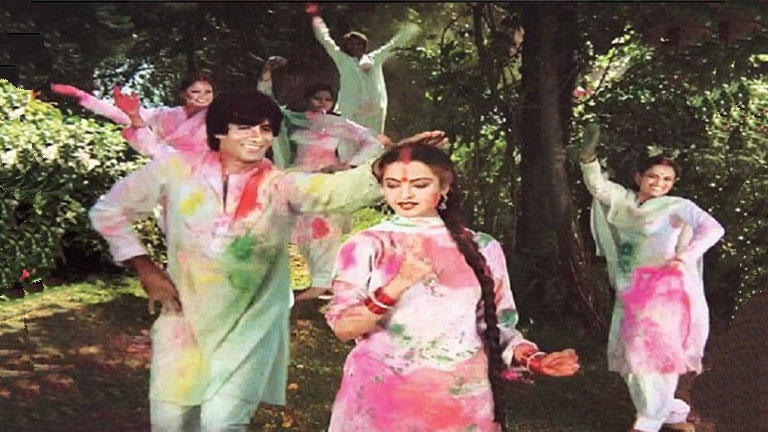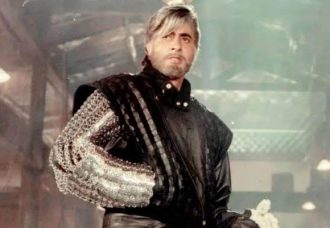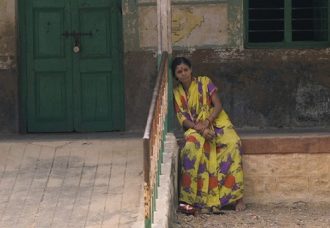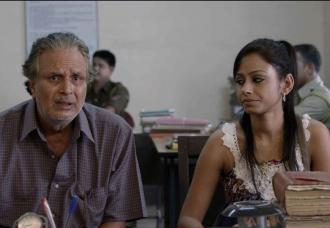“Holi kab hain, kab hain Holi!” Gabbar Singh screams in Sholay [1975]. The next frame, instilling fear in the audience, is a color palette in “out of focus.” There was a sprinkle of Holi colors on the ground, and ornament-clad hands quickly picked up powder from dishes left on the ground, filling phiskaris with color-mixed water at the same rate at which they picked up the powder. There is no complete human figure on the screen, only close-ups of a few hands that appear in the background. After a few shots that covered only twelve seconds, a group of girls comes out of the yard of a house, singing – come on, friends. The young man on the porch of another house was waiting with holi powder in his hand. He threw the color powder into the sky and joined the group that had arrived at that place. After that, the Holi song and dance started. Joy and excitement filled the dance song. Suddenly, a colorful shamiana catches fire, terrifying gunfire breaks out and a gang of robbers arrives. It was correctly assumed that it was Gabbar’s gang. Right before the song, Gabbar shouted, “When is Holi?” That was an indication that something would happen at the time of Holi. The director took a few relaxed moments before taking the audience into a terrifying atmosphere. Keeping the audience in a joyful atmosphere of dance and song, the director kept the character as well as the audience in a relaxed mood. This atmosphere was followed by a drastically opposite situation. This juxtaposition intensified the appeal of the Sequence. This song-dance sequence had no purpose in the development of the storyline, yet it added appeal of the following scene. The technique of using contrast sequences in a row is used only to make the atmosphere of terror.
This song from Sholay also includes some minute gestures to show the increasing closeness of Dharmendra and Hema Malini. The song includes two shots of Jaya Bhaduri standing still in front of a temple. He becomes speechless and motionless as he sees her amid the holicolors, and the excitement of the young people dancing at their peak. It is evident that director Ramesh Sippy’s effort was a success.
The song Rang Barse Bhige Chunarwali was rendered by Amitabh Bachchan in Yash Chopra’s 1981 film Silsila, in which he also played a lead role. For its successful production and picturization, this song is still considered to be one of the most popular Holi songs as a movie song. Amitabh Bachhan’s non-melodious voice adds a rustic element to this song, giving it a folk feel as if it were an actual folk song. This song is not a folk song; it was written by Harivansh Roy Bachchan based on a Meera bhajan. However, the lyrics were slightly changed to the Awadhi dialect of Hindi to create a feel of a folk song to meet the demand of the screenplay. The first two lines of the original Meera bhajan are as follows:
Rang Barse O Meera, Bhawan Mein Rang Barse..
Kaun e Meera tere mandir chinayo,
Kaun e chinayoterodevro
The music director duo Shiv-Hari [Pandit Shiv Kumar Sharma and Pandit Hariprasad Chourasia] composed the song based on Rajasthani and Haryanvi folk songs and used Kaharwa taal from Indian classical music. In the narrative of the film, the song was placed to explore the inner feelings and crises of the four lead characters played by Amitabh Bachchan, Jaya Bhaduri, Sanjeev Kumar and Rekha. The believable performance, supporting camera work, and sleek editing made the song worth watching and the song sequence served the narrative purpose.
While Amitabh and Rekha were in love, destiny compelled them to get married to different people; Amitabh married Jaya, while Rekha married Sanjeev Kumar. In spite of the fact that Jaya knows about Rekha, Sanjeev Kumar is unaware that both Amitabh and Rekha were in love with each other. This song provides Amitabh with an opportunity to express the love he suppresses for Rekha through the dance he performs. In the beginning, Amitabh sings alone, plays the drums with Sanjeev Kumar, and Rekha and Jaya are both smiling while the music is being played. In the following few seconds, he holds Rekha’s dupatta, then holds her hand and pulls her to dance when he holds her hand. Slowly the gap between them continues to narrow, Jaya cannot accept the fact that the two are getting closer, and at one point Sanjeev Kumar discovers something new about their intimacy and breaks down with sadness and frustration when he realises an unexpected thing. The song played a pivotal role in the growth and development of the plot of the film. Holi illustrates the character’s development, discovery, as well as disappointment in a colorful and lively environment, which creates a paradoxical moment within this sequence that makes it artistically engaging. Three decades have passed since the song and the film was released. In North India, however, the song is still considered one of the most popular film songs.








